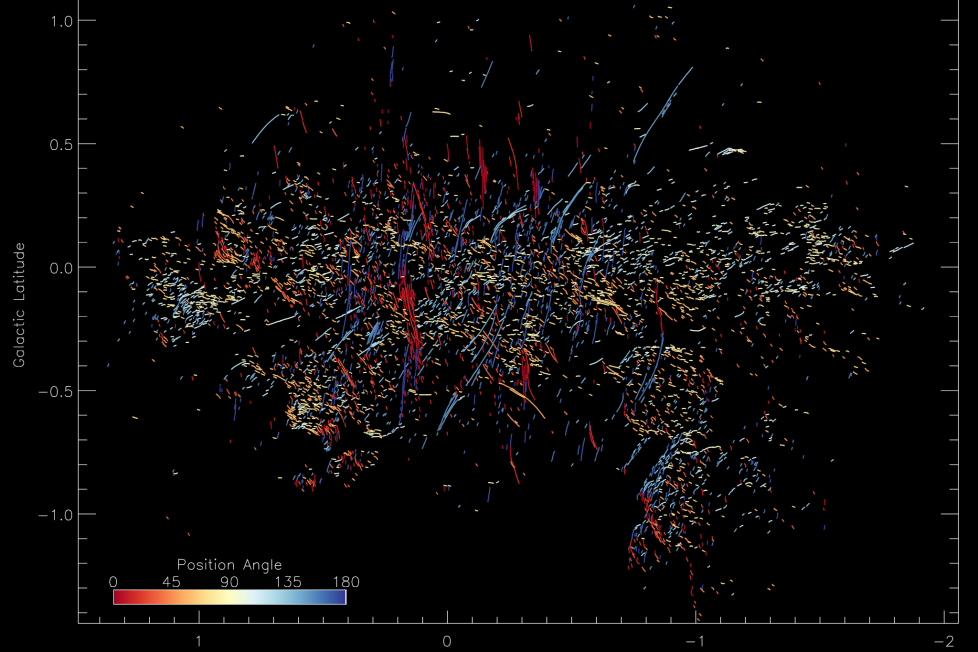Mysterious, Morse code-like ‘structures’ at center of Milky Way ‘stun’ astronomers

EVANSTON, Ill. — Astronomers have captured hundreds of mysterious filaments pointing towards the Milky Way’s supermassive black hole. They could help uncover secrets about the dark abyss at the center of our galaxy. The strange horizontal strands are 25,000 light years from Earth, with scientists comparing them to the dots and dashes of Morse code — only these appear to be floating through space!
“It was a surprise to suddenly find a new population of structures that seem to be pointing in the direction of the black hole,” says Professor Farhad Yusef-Zadeh of Northwestern University.
“I was actually stunned when I saw these. We had to do a lot of work to establish that we weren’t fooling ourselves. And we found that these filaments are not random but appear to be tied to the outflow of our black hole. By studying them, we could learn more about the black hole’s spin and accretion disk orientation. It is satisfying when one finds order in a middle of a chaotic field of the nucleus of our galaxy,” continues Yusef-Zadeh, a professor of physics and astronomy at Northwestern’s Weinberg College of Arts and Sciences, in a university release.
Known as Sagittarius A*, the black hole is a staggering four million times the mass of our Sun. Four decades ago, Prof. Yusef-Zadeh discovered nearby vertical threads, towering up to 150 light years high. The new population are much shorter, measuring less than 10 light years in length and lying horizontally. The Morse code-like pattern punctuates only one side of Sagittarius A*.
Last year, the same team revealed nearly 1,000 vertical filaments, which appeared in pairs and clusters, often stacked equally spaced or side-by-side like strings on a harp. The flood of new discoveries is coming from enhanced technology, particularly the South African Radio Astronomy Observatory’s (SARAO) MeerKAT telescope. To pinpoint the filaments, the researchers used a technique to remove the background and smooth the noise from images to isolate them from surrounding structures.
“The new MeerKAT observations have been a game changer,” Yusef-Zadeh says. “The advancement of technology and dedicated observing time have given us new information. It’s really a technical achievement from radio astronomers.”
The Northwestern astronomer was shocked to uncover the horizontal counterparts, estimated to be about six million years-old.
“We have always been thinking about vertical filaments and their origin,” the study author adds. “I’m used to them being vertical. I never considered there might be others along the plane.”
Both groups comprise one-dimensional filaments that scientists can see using radio waves. They appear to be tied to activities in the galactic center. However, the vertical filaments are perpendicular to the galactic plane while those that are horizontal are parallel and point radially toward our galaxy’s black hole.
The former are magnetic and encompass particles moving at speeds near the speed of light. The latter appear to emit thermal radiation, accelerating material in a molecular cloud. There are several hundred vertical strands compared to just a few hundred horizontal ones.
“One of the most important implications of radial outflow that we have detected is the orientation of the accretion disk and the jet-driven outflow from Sagittarius A* along the galactic plane,” Yusef-Zadeh explains.
The new discovery is filled with unknowns and work to unravel its mysteries is just beginning. For now, the study author can only consider a plausible explanation about the new population’s mechanisms and origins.
“We think they must have originated with some kind of outflow from an activity that happened a few million years ago,” Yusef-Zadeh says. “It seems to be the result of an interaction of that outflowing material with objects near it. Our work is never complete. We always need to make new observations and continually challenge our ideas and tighten up our analysis.”
Black holes are formed when a dying star collapses inward under the pressure of its own weight. This leads to a supernova, a star’s extremely powerful explosion. Black holes are places in space where the pull of gravity is so strong that even light can’t escape. This is what makes them invisible. Supermassive black holes can be billions of times the size of our Sun. Astronomers believe they can be found at the center of all large galaxies in the universe.
The study is published in The Astrophysical Journal Letters.
South West News Service writer Mark Waghorn contributed to this report.
